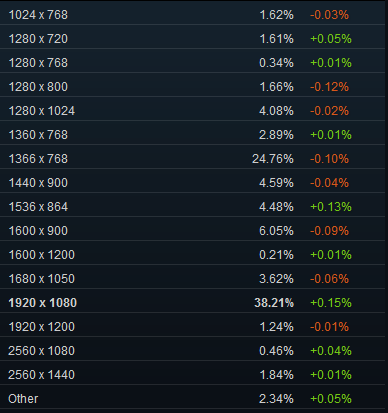Resident Evil 7: Biohazard, Benchmarked
Our Test Setup And Benchmark Procedure
Test Setup
| CPU | Core i5-6500 |
| Motherboard (Socket 1151) | Asus Z170-Deluxe |
| RAM | Klevv DDR4-2133 8GB |
| SSD | MX500 SSD |
| Controller | Intel PCH Z170 SATA 6Gb/s |
| Power Supply | Cooler Master G450M |
| Case | Haf XB EVO |
| OS | |
| Operating System | Windows 10 x64 Enterprise 1607 (14393.693) |
| Drivers | Nvidia GeForce Game Ready 378.49AMD Radeon Crimson Edition 17.1.1 |
We went with a fairly mid-range platform, similar to what a lot of mainstream gamers use to play on. The survey of hardware and software configurations for Steam users, presently the largest PC gaming platform, offers us a view of the most prevalent gaming setups in use (data from December 2016) :
- Windows 10 64-bit representing 49% of the market
- 8GB RAM is common across 33% of gamers (our configuration has 16GB)
- Full HD resolution (1920x1080) is used by more than one-third of gamers (38%, actually), while 25% remain at 1366x768, likely on laptops. QHD (2560x1440) is used by fewer than 2% of gamers, and 4K is just anecdotal.
- Quad-core CPUs are used by 48% of players. Our configuration employs a mid-range quad-core Intel CPU.
Graphics Card Choices
We're testing with six different graphics cards, most of which land in the mid-range category.
The Radeon RX 480 “Core” from XFX is at a disadvantage, given its stock clock rate, compared to Asus' GeForce GTX 1060 Strix OC operating at 1645 MHz. We overclocked the AMD card +4% to the level of a higher-end model, yielding a GPU frequency of 1340 MHz and a memory clock of 2 GHz.
These two cards are entry-level for the mid-range. AMD's Radeon RX 470 could have an advantage with its additional gigabyte of memory. It certainly won't go wasted in Resident Evil 7.
The GTX 970 and R9 390 are a generation old, but remain widely used by PC gamers who bought in when they were still modern. We chose them more for their popularity in gaming machines than their price (which is quite variable).
Test Procedure
All measurements are collected using PresentMon and a custom front-end written in-house, which facilitates a number of sensor readings as the performance results are generated. Check out PresentMon: Performance In DirectX, OpenGL, And Vulkan for more information about our methodologies.
In order for graphics card performance to be truly representative of reality, we take care to warm each contender up prior to taking measurements. The majority of cards operate at higher boost frequencies initially. Then, as the GPUs get hot, their clock rates fall somewhat and eventually stabilize. Benchmarks run in the interim convey better-than real-world frame rates.
Get Tom's Hardware's best news and in-depth reviews, straight to your inbox.
We therefore let the game run for five minutes to warm up the card, then we record its performance during the test sequence. Again, the measurements are taken at Full HD resolution with all options set to maximum, HBAO+ active, and anti-aliasing set to FXAA+TAA. Each test runs twice, activating and deactivating Shadow Caching for a purpose we will see later on.
MORE: Best Gaming Laptops
MORE: All Laptop Content
Current page: Our Test Setup And Benchmark Procedure
Prev Page The Game And Graphics Options Next Page Results: FPS, Frame Time And Smoothness-
Verrin Great analysis! I hope you guys do more game-specific benchmarks, I can't remember seeing them too often on here anymore. :)Reply -
waltsmith Not being a fanboy for this comment, this certainly sounds like another example of Nvidia strong arming a game developer to only put the green team card on the recommended specs. This kind of stuff leaves a very bad taste in my mouth.Reply -
stairmand Now if only that would fix multi-screen, extra wide monitors and bigger FOVs. (anyone hoping that they already said they wont)Reply -
anzweidrej69 @STAIRMANDReply
Capcom response about FOV cap
http://www.pcgamer.com/capcom-explains-why-resident-evil-7s-fov-is-capped-at-90/ -
photonboy CPU and MEMORY USAGE:Reply
You talk about more memory usage on the RX-480 8GB vs GTX1060 6GB but don't state if that's a positive or negative. Was there a POINT to that?
Tying in with that is CPU usage:
"The difference in CPU utilization is noticeable, to AMD's advantage. This isn't particularly surprising for a console port."
Since the GTX1060 6GB is using all 6GB's of it's memory it's quite possible that the higher CPU usage is due to memory swapping between system memory and video memory so I'd be careful about making specific points if you aren't certain of the reasons (or pointing out memory usage with no point made at all.. ). -
MarkTech Worst RE of all, clearly a rip-off of Outlast, if you wnt truly survival horror packed with action, there is RE:2 and RE:3, still the best two games of the franchiseReply
